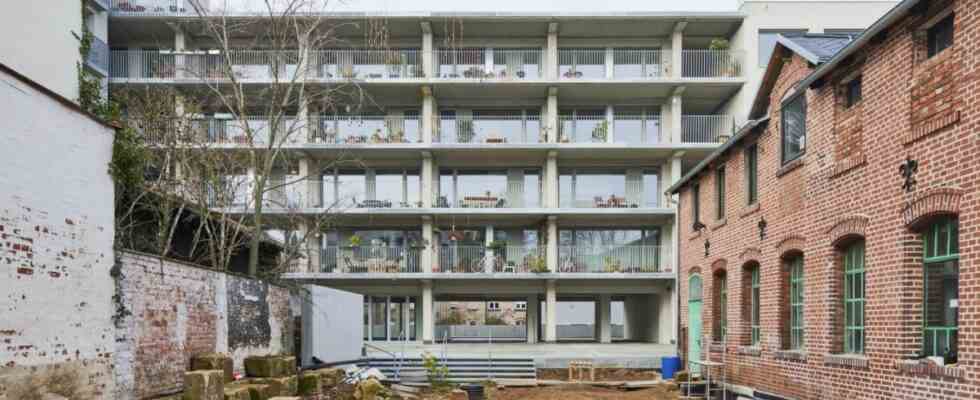Since 2005, the German Book Trade Association has been awarding the best German-language novel of the year, before which a long and short list is published. What kind of moaning was that at first, you might even have heard yourself grumbling: what’s the point of these crappy best-of lists, is it really supposed to be used to sort the value of art? Well, the winners of this contest since then have included Arno Geiger with “Es geht uns gut”, Eugen Ruge with “In Zeiten desahndens Lichts”, Ursula Krechel with “Landgericht”, Lutz Seiler with “Kruso” and Saša Stanišić with “Origin”. . And would anyone seriously claim that these books don’t make both readers and literary scholars happy?
This award has long since been the means of the post-Ranicki era to draw attention to exceptional literature in an unmistakable way – so it does exist, the collective jury intelligence. Since 2007 – two years after the book prize – the Deutsches Architekturmuseum (DAM), which is based in Frankfurt like the Börsenverein, has been awarding outstanding buildings in Germany every year. As with the book prize, there is a shortlist, but unless you are grossly mistaken, it is much less common knowledge. Which is a pity, since reasonably successful architecture shapes everyday life at least as much as good books.
For the DAM Prize for Architecture in Germany, the museum first nominates 100 remarkable buildings or ensembles, and a jury then selects “around 20 buildings from the shortlist” from among the nominations. The rules for the book prize are stricter, there are always exactly 20. The architecture jury is given more leeway: this time it awarded prizes to 23 buildings for the 2023 shortlist, seven of them from Bavaria.
Almost a third, which isn’t so bad. It is striking that three of these seven buildings are located in Munich: the Isarphilharmonie (gmp Architects von Gerkan, Marg and Partners), the Volkstheater (LRO Lederer Ragnarsdóttir Oei) and the DAV Federal Office (ELEMENT ∙ A Architekten BDA). In terms of percentage, the state capital is clearly ahead in this ranking, which could be a coincidence, but apparently isn’t. The DAM Prize has been awarded 15 times so far, four times the winner came from the Free State of Bavaria – and in all these cases from Munich.
Also on the shortlist is the general refurbishment and addition of a storey to the courthouse in Aschaffenburg (architects’ cooperative Fthenakis Ropee).
(Photo: Alexander Fthenakis)
According to the jury, Stephanie Hirschvogel Architects succeeded in creating a “symbiosis of old and new” with the Green House in Schongau.
(Photo: Philip Heckhausen)
And when the district office in Starnberg was expanded by the office of Auer Weber Associates, there was no break between what already existed and what was added.
(Photo: Aldo Amoretti)
This could now be taken for a bad metropolitan-centric thinking of a city jury. Or simply attest that a perceived observation is simply correct: the Bavarian cities and small towns outside of Munich expressly like many things Not lack. In terms of exciting contemporary architecture, unfortunately, yes. Shortlisted buildings in Nuremberg, Augsburg, Regensburg, Würzburg, Ingolstadt or Erlangen? Unfortunately none.
So not a single major city outside of Munich in Bavaria? But: Fuerth. According to the jury, the award-winning building by the architects Heide & von Beckerath on the site of a former mirror factory implements “community-oriented living in a diverse, cross-generational house community” and leads to a mixture of cooperative apartments and home ownership. The old smithy was preserved for this purpose, and a bicycle workshop is being built there, among other things. The building also draws attention to a fact that is not overly widespread: Fürth was once the city of mirrors – at the end of the 19th century there were 78 companies listed there that made their money with mirrors or by-products.
The general refurbishment and addition of a storey to the courthouse in Aschaffenburg, which has been listed as an outstanding example of the architecture of the reconstruction since 2012, also made it onto the list. Major criminal cases were last heard in containers in this complex – and apparently the patience has now paid off. The jury praised the architects’ cooperative Fthenakis Ropee above all for the extension as a “confident, contemporary addition to the existing ensemble” without directly quoting or even continuing the formal language of the old building.
In addition to two buildings in Franconia, two in Upper Bavaria also made it onto the list (which also means: none in Swabia or East Bavaria). According to the jury, Stephanie Hirschvogel Architects succeeded in creating a “symbiosis of old and new” with the Green House in Schongau. During the renovation of the former town farmer’s estate in the late medieval old town, it was possible to modernize ailing building fabric and at the same time to create space for upscale city apartments with bright living rooms, open kitchens, spacious floor plans and access without thresholds.
According to the Frankfurt jury, the extension of the district office in Starnberg by the office of Auer Weber Associates was designed in such a way that the existing building from the late 1980s, which has already received an award, “largely resembles the existing building” both in its external and internal form, and thus there is no break between the existing and the Added arise. Visitors are given the feeling of moving in a house “from a single source” despite structural and energy-related improvements and a transformation of certain details.
According to the German Architecture Museum, “three to four buildings” will now be selected from the 23 buildings for a shortlist of finalists. Finally, in January 2023, the winning building will be announced.

